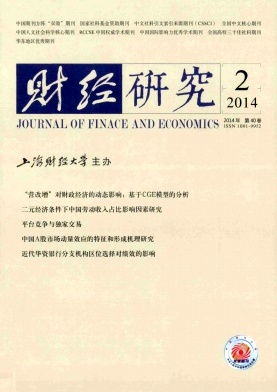中国A股市场动量效应的特征和形成机理研究
财经研究 2014 年 第 40 卷第 02 期, 页码:97 - 107
摘要
参考文献
摘要
动量效应不仅是学术研究的热点,而且在实务上也有广泛的应用。长期以来,关于我国股票市场是否存在动量效应一直存在争议,而且现有研究缺乏对动量效应的表现形式、利润来源和形成机理的深入剖析。基于此,文章利用我国A股市场1994-2011年股票收益率数据对动量效应进行了重新检验。结果表明:(1)我国A股市场不存在显著的月度频率上的动量效应,而当形成期为2-4周、持有期为1-3周时则存在稳定的动量收益;(2)规模、账面市值比和行业等因素可以解释约50%的动量收益;(3)现有行为金融理论并不能解释我国动量效应在不同规模、不同账面市值比和不同换手率股票间的显著差异,动量效应在赢家组合和输家组合中具有不同的形成机理。
[1]方军雄.我国证券投资基金投资策略及绩效的实证研究[J].经济科学,2002,(4):64-71.
[2]黄静,高飞.基金投资行为与投资绩效实证研究[J].证券市场导报,2005,(2):23-27.
[3]刘博,皮天雷.惯性策略和反转策略:来自中国沪深A股市场的新证据[J].金融研究,2007,(8):154-166.
[4]鲁臻,邹恒甫.中国股市的惯性与反转效应研究[J].经济研究,2007,(9):145-155.
[5]攀登,施东晖,曹敏.中国个人投资者采用股价趋势交易策略的经验研究[J].世界经济,2003,(11):71-77.
[6]潘莉,徐建国.A股个股回报率的惯性与反转[J].金融研究,2011,(11):149-166.
[7]沈可挺,刘煜辉.中国股市中惯性与反向投资策略的获利模式[J].管理科学学报,2006,(6):35-45.
[8]王永宏,赵学军.中国股市“惯性策略”和“反转策略”的实证分析[J].经济研究,2001,(6):56-89.
[9]王志强,王月盈,徐波,等.中国股市动量效应的表现特征[J].财经问题研究,2006,(11):46-55.
[10]徐信忠,郑纯毅.中国股票市场动量效应成因分析[J].经济科学,2006,(1):85-99.
[11]朱战宇,吴冲锋,王承炜.不同检验周期下中国股市价格动量的盈利性研究[J].世界经济,2003,(8):62-67.
[12]Barberis N,Shleifer A,Vishny R.A model of investor sentiment[J].Journal of Financial Economics,1998,49(3):307-343.
[13]Chordia T,Shivakumar L.Momentum,business cycle,and time-varying expected returns[J].Journal of Finance,2002,57(2):985-1019.
[14]Chui A C W,Titman S,Wei K C J.Individualism and momentum around the world[J].Journal of Finance,2010,65(1):361-392.
[15]Conrad J,Kaul G.An anatomy of trading strategies[J].Review of Financial Studies,1998,11(3):489-519.
[16]Daniel K,Hirshleifer D,Subrahmanyam A.Investor psychology and security market under-and overreactions[J].Journal of Finance,1998,53(6):1839-1885.
[17]Daniel K,Titman S.Evidence on the characteristics of cross sectional variation in stock returns[J].Journal of Finance,1997,52(1):1-33.
[18]Daniel K,Titman S.Market efficiency in an irrational world[J].Financial Analysts Journal,1999,56(6):28-40.
[19]Fama E F,French K R.Common risk factors in the returns on stocks and bonds[J].Journal of Financial Economics,1993,33(1):3-56.
[20]Fama E F,French K R.Multifactor explanations of asset pricing anomalies[J].Journal of Finance,1996,51(1):55-84.
[21]Fama E F,French K R.Size,value,and momentum in international stock returns[J].Journal of Financial Economics,2012,105(3):457-472.
[22]Griffin J M,Ji X Q,Martin J S.Momentum investing and business cycle risk:Evidence from pole to pole[J].Journal of Finance,2003,58(6):2515-2547.
[23]Grundy B D,Martin J S.Understanding the nature of the risks and the source of the rewards to momentum investing[J].Review of Financial Studies,2001,14(1):29-78.
[24]Hong H,Lim T,Stein J C.Bad news travels slowly:Size,analyst coverage,and the profitability of momentum strategies[J].Journal of Finance,2000,55(1):265-295.
[25]Hong H,Stein J C.A unified theory of underreaction,momentum trading,and overreaction in asset markets[J].Journal of Finance,1999,54(6):2143-2184.
[26]Hong H,Stein J C.Disagreement and the stock market[J].Journal of Economic Perspectives,2007,21(2):109-128.
[27]Jegadeesh N.Evidence of predictable behavior of security returns[J].Journal of Finance,1990,45(3):881-898.
[28]Jegadeesh N,Titman S.Returns to buying winners and selling losers:Implications for stock-market efficiency[J].Journal of Finance,1993,48(1):65-91.
[29]Jegadeesh N,Titman S.Profitability of momentum strategies:An evaluation of alternative explanations[J].Journal of Finance,2001,56(2):699-720.
[30]Jegadeesh N,Titman S.Cross-sectional and time-series determinants of momentum returns[J].Review of Financial Studies,2002,15(1):143-157.
[31]Kang Q,Li C.Predicted returns and sources of momentum profits[R].Working Paper,2009.
[32]Kang J,Liu M H,Ni S X.Contrarian and momentum strategies in the China stock market:1993-2000[J].Pacific-Basin Finance Journal,2002,10(3):243-265.
[33]Lee C M C,Swaminathan B.Price momentum and trading volume[J].Journal of Finance,2000,55(5):2017-2069.
[34]Moskowitz T J,Grinblatt M.Do industries explain momentum?[J].Journal of Finance,1999,54(4):1249-1290.
[35]Rouwenhorst K G.International momentum strategies[J].Journal of Finance,1998,53(1):267-284.
[36]Verardo M.Heterogeneous beliefs and momentum profits[J].Journal of Financial and Quantitative Analysis,2009,44(4):795-822.
[37]Zhang X F.Information uncertainty and stock returns[J].Journal of Finance,2006,61(1):105-136.
①这些研究都是利用股票月度收益率数据,检验买入过去6个月表现最好的股票、卖出过去6个月表现最差的股票的获利性。
②潘莉和徐建国(2011)选取的样本期间为1995-2008年,他们采用不同时间频率上的数据验证了动量效应的存在性,但没有探讨动量效应的成因。
③Chordia和Shivakumar(2002)认为,滞后期的平均股息和通货膨胀率等宏观经济变量可以解释动量收益。考虑到中国A股市场上只存在4周以内的动量效应,本文没有将低时间频率上的宏观经济变量作为共同因素。但本文引入了行业因素,这在一定程度上捕捉了宏观因素变化对股票收益的影响。
[2]黄静,高飞.基金投资行为与投资绩效实证研究[J].证券市场导报,2005,(2):23-27.
[3]刘博,皮天雷.惯性策略和反转策略:来自中国沪深A股市场的新证据[J].金融研究,2007,(8):154-166.
[4]鲁臻,邹恒甫.中国股市的惯性与反转效应研究[J].经济研究,2007,(9):145-155.
[5]攀登,施东晖,曹敏.中国个人投资者采用股价趋势交易策略的经验研究[J].世界经济,2003,(11):71-77.
[6]潘莉,徐建国.A股个股回报率的惯性与反转[J].金融研究,2011,(11):149-166.
[7]沈可挺,刘煜辉.中国股市中惯性与反向投资策略的获利模式[J].管理科学学报,2006,(6):35-45.
[8]王永宏,赵学军.中国股市“惯性策略”和“反转策略”的实证分析[J].经济研究,2001,(6):56-89.
[9]王志强,王月盈,徐波,等.中国股市动量效应的表现特征[J].财经问题研究,2006,(11):46-55.
[10]徐信忠,郑纯毅.中国股票市场动量效应成因分析[J].经济科学,2006,(1):85-99.
[11]朱战宇,吴冲锋,王承炜.不同检验周期下中国股市价格动量的盈利性研究[J].世界经济,2003,(8):62-67.
[12]Barberis N,Shleifer A,Vishny R.A model of investor sentiment[J].Journal of Financial Economics,1998,49(3):307-343.
[13]Chordia T,Shivakumar L.Momentum,business cycle,and time-varying expected returns[J].Journal of Finance,2002,57(2):985-1019.
[14]Chui A C W,Titman S,Wei K C J.Individualism and momentum around the world[J].Journal of Finance,2010,65(1):361-392.
[15]Conrad J,Kaul G.An anatomy of trading strategies[J].Review of Financial Studies,1998,11(3):489-519.
[16]Daniel K,Hirshleifer D,Subrahmanyam A.Investor psychology and security market under-and overreactions[J].Journal of Finance,1998,53(6):1839-1885.
[17]Daniel K,Titman S.Evidence on the characteristics of cross sectional variation in stock returns[J].Journal of Finance,1997,52(1):1-33.
[18]Daniel K,Titman S.Market efficiency in an irrational world[J].Financial Analysts Journal,1999,56(6):28-40.
[19]Fama E F,French K R.Common risk factors in the returns on stocks and bonds[J].Journal of Financial Economics,1993,33(1):3-56.
[20]Fama E F,French K R.Multifactor explanations of asset pricing anomalies[J].Journal of Finance,1996,51(1):55-84.
[21]Fama E F,French K R.Size,value,and momentum in international stock returns[J].Journal of Financial Economics,2012,105(3):457-472.
[22]Griffin J M,Ji X Q,Martin J S.Momentum investing and business cycle risk:Evidence from pole to pole[J].Journal of Finance,2003,58(6):2515-2547.
[23]Grundy B D,Martin J S.Understanding the nature of the risks and the source of the rewards to momentum investing[J].Review of Financial Studies,2001,14(1):29-78.
[24]Hong H,Lim T,Stein J C.Bad news travels slowly:Size,analyst coverage,and the profitability of momentum strategies[J].Journal of Finance,2000,55(1):265-295.
[25]Hong H,Stein J C.A unified theory of underreaction,momentum trading,and overreaction in asset markets[J].Journal of Finance,1999,54(6):2143-2184.
[26]Hong H,Stein J C.Disagreement and the stock market[J].Journal of Economic Perspectives,2007,21(2):109-128.
[27]Jegadeesh N.Evidence of predictable behavior of security returns[J].Journal of Finance,1990,45(3):881-898.
[28]Jegadeesh N,Titman S.Returns to buying winners and selling losers:Implications for stock-market efficiency[J].Journal of Finance,1993,48(1):65-91.
[29]Jegadeesh N,Titman S.Profitability of momentum strategies:An evaluation of alternative explanations[J].Journal of Finance,2001,56(2):699-720.
[30]Jegadeesh N,Titman S.Cross-sectional and time-series determinants of momentum returns[J].Review of Financial Studies,2002,15(1):143-157.
[31]Kang Q,Li C.Predicted returns and sources of momentum profits[R].Working Paper,2009.
[32]Kang J,Liu M H,Ni S X.Contrarian and momentum strategies in the China stock market:1993-2000[J].Pacific-Basin Finance Journal,2002,10(3):243-265.
[33]Lee C M C,Swaminathan B.Price momentum and trading volume[J].Journal of Finance,2000,55(5):2017-2069.
[34]Moskowitz T J,Grinblatt M.Do industries explain momentum?[J].Journal of Finance,1999,54(4):1249-1290.
[35]Rouwenhorst K G.International momentum strategies[J].Journal of Finance,1998,53(1):267-284.
[36]Verardo M.Heterogeneous beliefs and momentum profits[J].Journal of Financial and Quantitative Analysis,2009,44(4):795-822.
[37]Zhang X F.Information uncertainty and stock returns[J].Journal of Finance,2006,61(1):105-136.
①这些研究都是利用股票月度收益率数据,检验买入过去6个月表现最好的股票、卖出过去6个月表现最差的股票的获利性。
②潘莉和徐建国(2011)选取的样本期间为1995-2008年,他们采用不同时间频率上的数据验证了动量效应的存在性,但没有探讨动量效应的成因。
③Chordia和Shivakumar(2002)认为,滞后期的平均股息和通货膨胀率等宏观经济变量可以解释动量收益。考虑到中国A股市场上只存在4周以内的动量效应,本文没有将低时间频率上的宏观经济变量作为共同因素。但本文引入了行业因素,这在一定程度上捕捉了宏观因素变化对股票收益的影响。
引用本文
高秋明, 胡聪慧, 燕翔. 中国A股市场动量效应的特征和形成机理研究[J]. 财经研究, 2014, 40(2): 97–107.
导出参考文献,格式为:





 12213
12213  6916
6916

